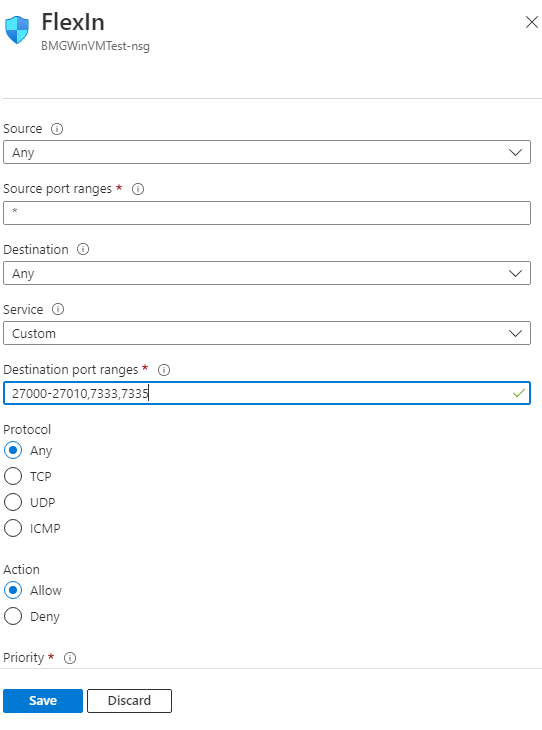Configuring a Cloud based Network License Server
A network license can be hosted on an AWS or Azure based server machine. Cloud based server machines must meet the requirements specified for physical server machines. For more information see Network License Server Requirements.
AWS Requirements
AWS virtual machines will need to meet the following requirements:
- The virtual instance requires a fixed ethernet address and hostname.
- It is recommended to specify a static vendor daemon port in the license file.
- All ports specified in the license file need to be opened and available on the firewall, in addition to the EC2 dashboard.
- Inbound and Outbound ports will need to be opened for both lmgrd.exe (the licensing service) and bmgeo.exe (the vendor daemon) in the EC2 dashboard. See the Configuring the License Server section for more detailed information.
Azure Requirements
Azure virtual machines will need to meet the following requirements:
- The virtual instance requires a fixed ethernet address and hostname.
- It is recommended to specify a static vendor daemon port in the license file.
- All ports specified in the license file need to be opened and available on the firewall, in addition to the Azure Portal interface.
- Inbound and Outbound ports will need to be opened for both lmgrd.exe (the licensing service) and bmgeo.exe (the vendor daemon) in the Azure Portal Interface. See the Configuring the License Server section for more detailed information.
Configuring the License Server
For any cloud based licensing server, it is recommended to specify a static vendor daemon port, and add inbound/outbound port rules for both ports specified in the license file. The following section includes an example of performing this configuration for an Azure based server, but the same basic method can also be applied to AWS based server machines.
The License File
Below is an example of an updated license file that contains a set of ports to be used for the service:

On the first line following the Machine ID for the server, there is an outgoing port (set to 27000 by default, but changed to 7333 in the screenshot above) that will directly be used by Global Mapper. On the second line there is an additional port for the bmgeo service set to 7335. This second port is not static by default. It is recommended to set this port by adding port=insert port number here to the second line in the license file.
Configuring the Virtual Machine
Once both port numbers have been specified in the license file, inbound and output rules need to be specified in the virtual machine dashboard.
- .Inside the Azure Portal, navigate to the Networking configuration section. This will open several tabs for port rules, security, and load balancing. Select the "Inbound Port Rules" tab, and then click Add inbound port rules.
- This will open another configuration dialog allowing for custom port rules to be created for the current Virtual Machine instance. Once it is open, you will need to add the standard Flexlm ports (27000-27010) and the two custom ports defined in the license file for both UDP and TCP. If the ports specified in the license file are not available, the service will default to using the standard Flexlm ports.

-
Once the inbound rules are set, repeat the process for the outbound port rules with the same settings as above.

-
This should open up all required ports for the FlexLM service for the Virtual Machine. For the final step you will need to remote desktop into the Virtual Machine and configure the local Windows Firewall. This will entail setting up inbound and outbound rules for the same ports described above for both UDP and TCP. Lastly, program exceptions should be added on the virtual machine for both lmgrd.exe and bmgeo.exe.
-
Once the steps above are completed, the standard Flexlm licensing tool configuration can be performed. Detailed instructions regarding this process can be found on Installing and Configuring the Network License for Global Mapper.
-
On the server operating system, go to Start>Run and type firewall.cpl.
-
Click on the “Advanced Settings” link on the left pane.
-
Windows Firewall with Advanced security UI opens up.
-
Click on the “Outbound” option.
-
In the right pane, click on “New rule”.
-
Under “Rule Type” select the option “Program” and click next.
-
Select the option “This Program path”.
-
Browse to the location of the bmgeo.exe and lmgrd.exe.
-
Select the option “Allow the connection”.
-
Click Next, do not change any option here and click Next again.
-
Specify a name for this rule.
-
Click Finish.
-
Repeat the process for Inbound program excepts as well for both EXEs.
-
On the client operating system, go to Start>Run and type firewall.cpl.
-
Click on the “Advanced Settings” link on the left pane.
-
Windows Firewall with Advanced security UI opens up.
-
Click on the “Inbound Rules” option.
-
In the right pane, click on “New rule”.
-
Under “Rule Type” select the option “Program” and click next.
-
Select the option “This Program path”.
-
Browse to the location of the GlobalMapper25.1.exe
-
Select the option “Allow the connection”.
-
Click Next, do not change any option here and click Next again.
-
Specify a name for this rule.
-
Click Finish.

Adding Firewall Exceptions:
Firewall exceptions may need to be added in cases where the firewall is blocking the connection between the server and client machines. This issue is common with (but not limited to) cloud servers.
Go to the Windows firewall and make an exception for bmgeo.exe and lmgrd.exe on the server and client machine, as well as exceptions for the Global Mapper.exe itself on the client end. You should be able to adjust to outbound for the server machine in the steps below.
To add a program exception on the server end:
To add a program exception on the client end: